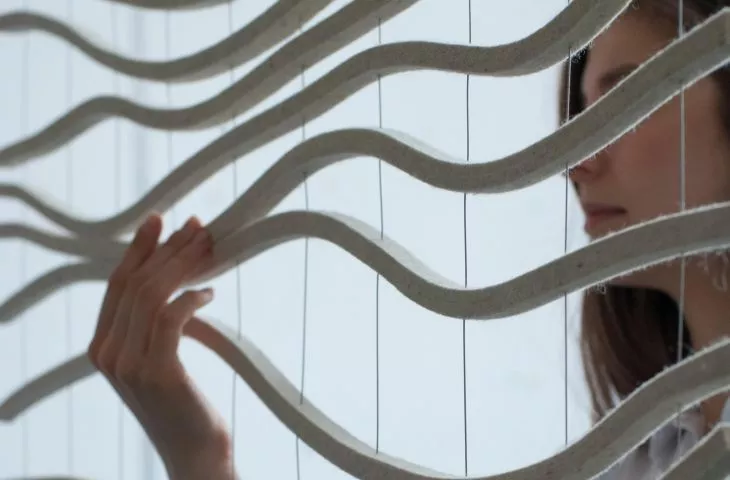The designer's design of space-separating elements is an alternative to the solutions present on the market, focusing mostly on the division and decoration of interiors. The work of Michal Dubanik from the Jan Matejko Academy of Fine Arts in Krakow, in a subtle way, using simple, natural materials, creates aesthetic division wherever it is needed.
Michal Dubanik decided to create a design of special space-separating elements that can be used in many rooms to introduce division. The proposed object also divides space in a symbolic way, thanks to its translucency and transformability. The base is made of steel cables, on which the author attached movable elements - strips made of technical felt. They can be moved up or down, creating full planes or openwork compositions. The result is a drawing effect in space, which is an alternative to current solutions on the market, focusing mostly on division and decoration.
The object is made of simple materials: steel cables and felt
© Michal Dubanik
The subject of space is an extremely capacious issue that can be explored and solved in many different ways. Despite constant artistic and design exploitation, it still remains inexhaustible. According to Immanuel Kant, space is a necessary imaginary. One cannot not so much remove it from thought as imagine its absence at all. Regardless of where we are and our emotional state, space will always accompany us, will be perpetually present. We are in a constant, sometimes unconscious relationship with it, whether we want it or not. Man himself builds the space around him and to some extent he himself is responsible for it. This is especially true of the places where we stay most often such as home, work, garden, etc. [...]. In nature, we observe how organisms adapt to the space that surrounds them, seeking shelter in it through camouflage or exposure. Similarly, humans, through their clothing or their homes. Our brain tells us when we feel safe or not. Man enters into a relationship with every object. Considering that at this moment almost everyone is carrying a phone we can see what, is the influence of objects on our lives. Often without having anything with us, we feel anxious and want to constantly surround ourselves with objects. Without them, we sometimes feel "naked." We get used to them and expect them to adapt to us," explains Michal Dubanik.
When creating the shape, the main aspect was the possibility of modifying the object
© Michal Dubanik
While working on the project, the author determined the points around which he built the concept: the user himself decides where the object will be used; the user can manipulate one or more elements; the impact on the senses is of great importance; the object can reflect the user's emotions; and the question: is one element or a set of elements needed?
One of the first problems the designer had to solve was determining the place of use - whether it should be a home, office or open space. When creating the shape, the main aspect was the possibility of modifying the object, the subjective feeling of isolation and aesthetic expression. The resulting levitating object in space, made of steel cables and felt, has considerable artistic potential, and its user is encouraged to create creative arrangements. Not only alone, but also with others, which supports integration and creativity.
Users influence the shape and density of the form
© Michal Dubanik
Dobrawa Bies: What were the main design inspirations?
Michal Dubanik: The main design inspirations were artistic and design treatments that touched on the notion of space in their intent. They explored space or simply created it. Not with walls or other panels to create it, but with subjective building blocks - for example, light. It was important to explore at what point a person would feel the division of space. The physical inspiration came from the studio STUDIO COPE/ARNOLD. Their photographs exploring different matter, what it looked like and what it created, propelled me to create a similar effect in my project as well.
Dobrawa: What was the work made of and how did the choice of materials influence its appearance?
Michael: The work was made of pressed wool (commonly known as felt) and steel cables. In the prototype, which was a snippet of the design, I had to add wooden slats to be able to show the principle of operation. What I really wanted was for the wool element to levitate in space. The strips of wool on the taut rope stop where you want and create a wonderful visual effect.
The design allows subjective separation of space
© Michal Dubanik
Dobrawa: How does the design "work" and what applications can it have?
Michal: The design enables subjective separation of space - we can see what is happening outside the object. The density of objects at eye level obscures the user and what is behind him. With the design, we can create a certain drawing in the space - a calming visual effect. My idea can be applied in many rooms where the division of space should not be so significant - in open space offices, or in apartments.
Dobrawa: Do you think good design can contribute to changing the lives of its recipients?
Michal: Good design contributes to changing lives. Where we don't look and what we don't touch is design. People choose things. Their senses and emotions determine what they need. Good design should affect the senses and emotions so that the user can experience something new or have the ability to reflect.
Dobrawa: Thank you for the interview.






































